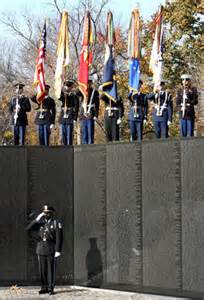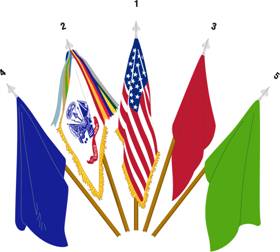The Flag of the United States of America

FOREVER MAY SHE WAVE!!!
The Pledge of Allegiance

I Pledge Allegiance to the flag of the United States of America and to the Republic for which it stands, one Nation under God, indivisible, with liberty and justice for all.
According to the Code of Laws of the United States of America (the compilation and codification of the general and permanent federal laws of our country), in Title 4, Chapter 1, Section 4, you will find the following:
"4 USC § 4 - Pledge of allegiance to the flag; manner of delivery"
The Pledge of Allegiance to the Flag: “I pledge allegiance to the Flag of the United States of America, and to the Republic for which it stands, one Nation under God, indivisible, with liberty and justice for all.”, should be rendered by standing at attention facing the flag with the right hand over the heart. When not in uniform men should remove any non-religious headdress with their right hand and hold it at the left shoulder, the hand being over the heart. Persons in uniform should remain silent, face the flag, and render the military salute.
To view the full Code of Laws of the United States, click here: http://www.law.cornell.edu/uscode/text

Display or Use of the United States Flag
When displaying, presenting, or using the US Flag with other flags, the United States Flag always holds the place of honor and precedence -- which means it is always placed to its own right (as it faces you, there are no flags to its right; as you are looking at it, there are no flags to its left).
When military branch flags are also in place, they are to be displayed in accordance to the date of the 'birth' of the branch which they represent. Confusion sometimes takes place with the proper placement of the Marine and Navy flags. The confusion comes in with the fact that the Navy was birthed on October 13, 1775 and the Marines on November 10, 1775 -- thus, many place the Navy flag before the Marine flag, not realizing that the Navy was abolished and our ships sold by the end of 1785. When our Constitution was ratified in 1789, Congress was authorized to re-establish the Navy -- and our country's Department of the Navy was formed on April 30, 1798 (thus placing it after the 'birth' of the Marines).
The U.S. Army birthday is June 14, 1775, created by an act of the Continental Congress, making it the first branch of the U.S. military. Its flag goes first when displayed with other military branch flags. The official United States Army flag currently being used was adopted by presidential order on June 12,1956.
The U.S. Marine Corps birthday is Nov. 10, 1775, created by an act of the Continental Congress. Its flag follows the U.S. Army flag. The design of the Marine Corps flag was adopted on January 18,1939.
The U.S. Navy official birthday is Oct. 13, 1775, but as the branch was abolished and then reinstatement, its flag follows the U.S. Marine Corps flag. The official United States Navy flag itself was authorized on April 24, 1959 and introduced to the public on April 30 of that year.
The U.S. Air Force birthday is Sept. 18, 1947, formed from the former Army Air Corps and created by the National Security Act of 1947. The order of display for its branch flag follows the U.S. Navy flag. The official flag of the Air Force was adopted in March 26, 1951.
The U.S. Coast Guard birthday is Aug. 4, 1790. The Coast Guard flag is displayed last because during peace time, the Coast Guard is a unit of the U.S. Department of Homeland Security (as of 2003) rather than the Department of Defense. During times of war, if the Coast Guard is moved by presidential order to become a unit of the U.S. Department of Defense, the flag's order would follow the Navy and precede the Air Force flag. The current flag for the Coast Guard was officially adopted on January 28, 1964.
THUS -- as we are facing the flags and looking at them in a line, it would be:
US FLAG - Army Flag - Marine Flag - Navy Flag - Air Force Flag - Coast Guard Flag.

In a display, the United States Flag may take the center position when it is taller then the other flags and is placed to the front. The other flags would then be placed in the order of precedence: to the left, then to the right -- to the left, and then to the right -- etc.

For more information on the specifics of the display of the United states Flag, see Title 4, Chapter 1, Section 7, of the Code of Laws of the United States:
"4 USC § 7 - Position and manner of display"

TODAY: Is the United States flag to be at full or half staff?
Know the daily flag status of the United States Flag. To the left is today's time, date, and national flag status. To the right you will find notifications of National and Connecticut (home of Precious Stars) Half Staff Notifications and the reason for them
States lower their United States flags to half staff in accordance with National flag status and also per order of the Governor of the State on specific occasions (other States may or may not lower their flags on the date, it will depend on that State's governor).

While serving as the 2009 - 2010 National Patriotic Instructor for the Blue Star Mothers of America, I wrote the following article:
![]()

![]()
Please click the Topsites symbols to vote for this site and to find other troop/veteran support sites:
![]()
This website is being worked on each day. Please check back often, as more pages will be added and more information placed on the pages that are here. If you have any questions, please feel free to contact me. If you wish to have information added, make corrections, have comments, or find a link that no longer works, please let me know.
THANK YOU!
![]()
Please visit me on my other websites:
Women of Ministry / Women of Faith www.WomenofMinistryWomenofFaith.com
Faith and Life Ministries www.FaithandLifeMinistriesInternational.com
On the websites of those I am affiliated with:
Patriot Guard Riders www.PatriotGuard.org
Connecticut Patriot Guard Riders www.ctpatriotguard.org
Missing In America Project www.MIAP.us
VA Voluntary Service http://www.volunteer.va.gov/
Military Ministry http://www.militaryministry.org/
Christian Military Fellowship http://cmf.com/
VFW National Home For Children http://www.vfwnationalhome.org/
Post #296 VFW Ladies Auxiliary www.vfwpost296ladiesaux.com
Marine Corps League Auxiliary http://mcldeptct.org/pages/mcl_ct_auxiliary.html
American Soldier Memorial Project http://groups.yahoo.com/group/AmericanSoldierMemorial
No Soldier Left Behind Memorial http://groups.yahoo.com/group/NoSoldierLeftBehindMemorial/
JESUS My Lord and Savior Church www.JesusMyLordandSaviorChurch.com
Men Walking With God www.MenWalkingWithGod.com/

